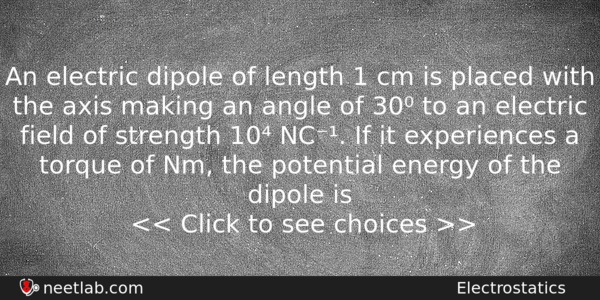| ⇦ | 
| ⇨ |
An electric dipole of length 1 cm is placed with the axis making an angle of 30⁰ to an electric field of strength 10⁴ NC⁻¹. If it experiences a torque of Nm, the potential energy of the dipole is
Options
(a) 2.45 J
(b) 0.0245 J
(c) 245.0 J
(d) 24.5 J
Correct Answer:
24.5 J
Explanation:
No explanation available. Be the first to write the explanation for this question by commenting below.
Related Questions: - The dimensions of mobility of charge carriers are
- An electron moves on a straight line path XY as shown. The abcd is a coil adjacent
- The quantity having the same units in all systems of unit is
- Activity of a radioactive sample decreases to (1/3)rd of its original value
- A roller coaster is designed such that riders experience “weightlessness” as they
Topics: Electrostatics
(146)
Subject: Physics
(2479)
Important MCQs Based on Medical Entrance Examinations To Improve Your NEET Score
- The dimensions of mobility of charge carriers are
- An electron moves on a straight line path XY as shown. The abcd is a coil adjacent
- The quantity having the same units in all systems of unit is
- Activity of a radioactive sample decreases to (1/3)rd of its original value
- A roller coaster is designed such that riders experience “weightlessness” as they
Topics: Electrostatics (146)
Subject: Physics (2479)
Important MCQs Based on Medical Entrance Examinations To Improve Your NEET Score
18000+ students are using NEETLab to improve their score. What about you?
Solve Previous Year MCQs, Mock Tests, Topicwise Practice Tests, Identify Weak Topics, Formula Flash cards and much more is available in NEETLab Android App to improve your NEET score.
Share this page with your friends

Torque=PE sin¢
10√2= P×10^4 sin 30°
P=2√2×10^-3
U=PE cos 30°
U=2√2×10^-3× 10^4 cos 30°
=24.5 J
Torque=PE sin¢
10√2= P×10^4 sin 30°
P=2√2×10^-3
U=PE cos 30°
U=2√2×10^-3× 10^4 cos 30°
=24.5 J
Torque=PE sin¢
10√2= P×10^4 sin 30°
P=2√2×10^-3
U=PE cos 30°
U=2√2×10^-3× 10^4 cos 30°
=24.5 J